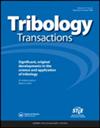Tribological Characteristics of Rotary Vane Steering Gear Seals Under the Oil With Different Abrasive Particle Sizes
IF 2.2
3区 工程技术
Q2 ENGINEERING, MECHANICAL
引用次数: 0
Abstract
AbstractAbrasive particles often cause wear of the rotary vane seals during an operation process, and lead to seal failure and mechanical fault. Focusing on the wear mechanisms and extracting the tribological information during the friction are the prerequisites for extending the service life and carrying out the fault diagnosis prediction of rotary vane seals. Four different sizes of iron particles were selected to mix with the same volume of hydraulic oil to explore the effect of lubricating oil containing abrasive particles on the wear behaviors of the seal. The tribological behaviors during friction were comprehensively analyzed, including the coefficient of friction (COF), wear volume, surface topography, vibration, noise, and other information. The results demonstrated that the wear characteristics of the seal’s contact surfaces changed obviously. The wear morphologies, coefficients of friction, surface roughnesses, and vibration signals increased with the increase of the abrasive particles’ size, with the wear state gradually worsening. When the iron particle size reached 160 μm, the COF increased by 0.047, and the peak vibration signal increased from 4.31 to 36.97 m/s2, compared with pure hydraulic oil lubrication. This tribological information could disclose the wear mechanisms of thermoplastic polyurethanes (TPU) and reveal the TPU wear states. Determining the tribological information for the rubbing pairs was a potential and effective way for evaluating or predicting the rotary vane steering gear seals’ wear states or failure modes. This study lays the foundation for understanding the wear mechanisms and the fault diagnosis of steering gear seals.Keywords: Abrasive wearwear mechanismsfrictionfailure analysis Disclosure StatementNo potential conflict of interest was reported by the author(s).Additional informationFundingThis work was supported by the National Natural Science Foundation of China (52075399) and the High-Tech Ship Research Project of Ministry of Industry and Information Technology [MIIT [CJ02N20]].不同磨粒油作用下转叶舵机密封件的摩擦学特性
摘要在运转过程中,磨料颗粒经常引起旋片密封的磨损,导致密封失效和机械故障。关注旋转叶片密封的磨损机理,提取摩擦过程中的摩擦学信息,是延长其使用寿命和进行故障诊断预测的前提。选择4种不同尺寸的铁颗粒与相同体积的液压油混合,探讨含磨粒的润滑油对密封磨损行为的影响。综合分析了摩擦过程中的摩擦学行为,包括摩擦系数、磨损量、表面形貌、振动、噪声等信息。结果表明,密封接触表面的磨损特性发生了明显的变化。磨损形貌、摩擦系数、表面粗糙度和振动信号随着磨粒尺寸的增大而增大,磨损状态逐渐恶化。当铁颗粒尺寸达到160 μm时,与纯液压油润滑相比,COF增加了0.047,峰值振动信号从4.31增加到36.97 m/s2。这些摩擦学信息可以揭示热塑性聚氨酯(TPU)的磨损机理,揭示TPU的磨损状态。确定摩擦副的摩擦学信息是评估或预测旋转叶片舵机密封件磨损状态或失效模式的一种潜在而有效的方法。本研究为了解舵机密封件的磨损机理和故障诊断奠定了基础。关键词:磨料磨损磨损机理摩擦失效分析披露声明作者未报告潜在利益冲突。本工作得到国家自然科学基金(52075399)和工业和信息化部高技术船舶研究项目[MIIT] [CJ02N20]的资助。
本文章由计算机程序翻译,如有差异,请以英文原文为准。
求助全文
约1分钟内获得全文
求助全文
来源期刊

Tribology Transactions
工程技术-工程:机械
CiteScore
3.90
自引率
4.80%
发文量
82
审稿时长
4 months
期刊介绍:
Tribology Transactions contains experimental and theoretical papers on friction, wear, lubricants, lubrication, materials, machines and moving components, from the macro- to the nano-scale.
The papers will be of interest to academic, industrial and government researchers and technologists working in many fields, including:
Aerospace, Agriculture & Forest, Appliances, Automotive, Bearings, Biomedical Devices, Condition Monitoring, Engines, Gears, Industrial Engineering, Lubricants, Lubricant Additives, Magnetic Data Storage, Manufacturing, Marine, Materials, MEMs and NEMs, Mining, Power Generation, Metalworking Fluids, Seals, Surface Engineering and Testing and Analysis.
All submitted manuscripts are subject to initial appraisal by the Editor-in-Chief and, if found suitable for further consideration, are submitted for peer review by independent, anonymous expert referees. All peer review in single blind and submission is online via ScholarOne Manuscripts.
 求助内容:
求助内容: 应助结果提醒方式:
应助结果提醒方式:


